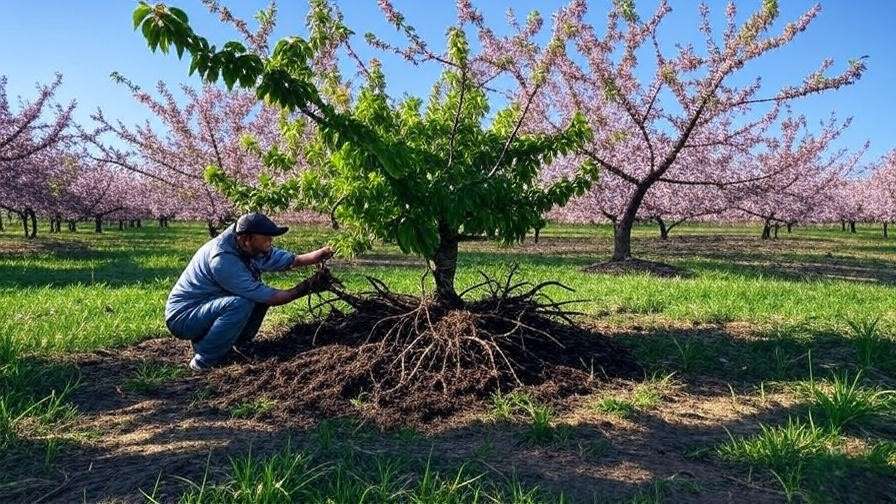Imagine stepping into your backyard, eager to pick ripe cherries, only to find your tree’s leaves wilting and its fruit sparse. Despite your care, something’s wrong beneath the soil. This is often the silent devastation of cherry tree root rot, a sneaky disease that can destroy your orchard if left unchecked. But don’t despair! With the right knowledge, you can identify and prevent cherry tree root rot, ensuring your trees thrive for years. In this comprehensive guide, we’ll walk you through expert-backed steps to diagnose, treat, and prevent root rot, drawing on insights from arborists and horticulturists to help you grow a flourishing cherry orchard. 🌿
What Is Cherry Tree Root Rot? 🕵️♀️
Understanding Root Rot and Its Causes
Root rot is a destructive condition caused by fungal or waterborne pathogens that attack a tree’s root system, compromising its ability to absorb water and nutrients. In cherry trees, common culprits include Phytophthora, Armillaria mellea (honey fungus), and Rhizoctonia. These pathogens thrive in specific conditions:
- Poor drainage: Waterlogged soils suffocate roots, creating a breeding ground for fungi.
- Overwatering: Excessive moisture weakens roots, making them susceptible to infection.
- Compacted soil: Dense soil restricts root growth and oxygen flow.
Cherry trees are particularly vulnerable due to their preference for well-drained, loamy soils. Heavy clay or soggy conditions can spell disaster, especially for young trees. Understanding these triggers is the first step to protecting your orchard.
The Impact of Root Rot on Cherry Trees
Root rot’s damage starts below ground but soon becomes visible above. Infected roots turn dark, mushy, and emit a foul odor, cutting off the tree’s lifeline. Above ground, you’ll notice:
- Wilting or yellowing leaves: Even with regular watering, leaves droop or turn yellow.
- Stunted growth: New shoots and branches fail to develop fully.
- Reduced fruit yield: Cherries may be small, discolored, or drop prematurely.
If untreated, root rot can kill a tree within a season. For example, a small orchard in Washington lost 30% of its cherry trees to Phytophthora root rot after heavy spring rains, highlighting the importance of early detection.
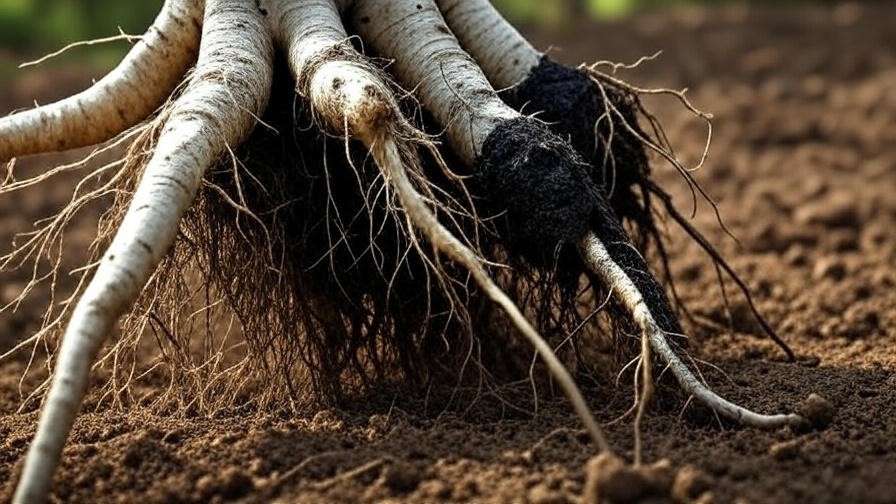
How to Identify Cherry Tree Root Rot 🔍
Above-Ground Warning Signs
Spotting root rot early can save your cherry tree. Look for these telltale symptoms:
- Yellowing or wilting leaves: Leaves may appear scorched or droop, even with adequate water.
- Premature leaf drop: A sparse canopy in spring or summer is a red flag.
- Poor fruit production: Small, discolored, or sparse cherries indicate root stress.
For visual clarity, compare your tree to healthy cherry trees. A healthy tree has vibrant green leaves and a full canopy, while a struggling tree looks lackluster. Check online resources from university extensions for images of these symptoms to confirm your observations.
Below-Ground Inspection Techniques
To confirm root rot, inspect the roots:
- Dig carefully: Use a shovel to excavate a small area around the root zone, about 6–12 inches from the trunk.
- Examine roots: Healthy roots are firm, white, and fibrous. Rotted roots are dark, soft, and may smell like decay.
- Compare: If only some roots are affected, the tree may still be savable.
Expert Tip: Use a soil probe or auger for a less invasive check. These tools allow you to sample soil and roots without disturbing the tree excessively.
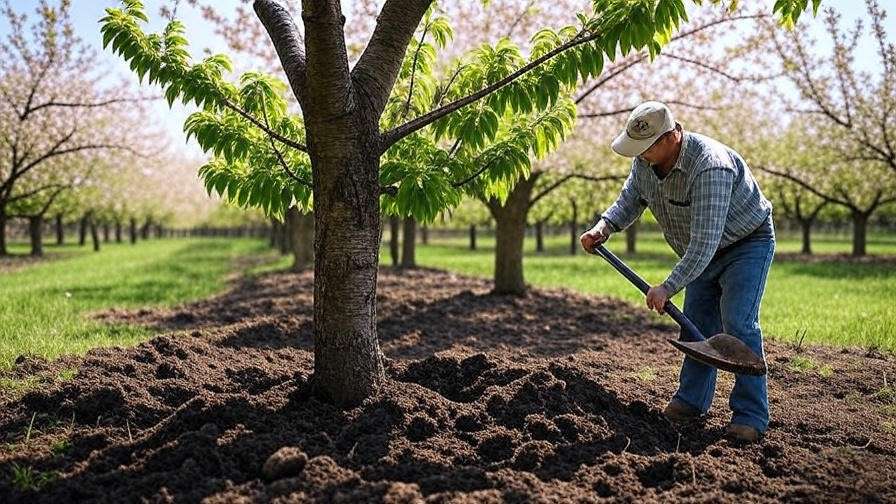
Diagnostic Tools and Tests
For precise diagnosis:
- Soil testing: Send samples to a local agricultural extension service or use a DIY fungal detection kit. These tests identify pathogens like Phytophthora.
- Consult an arborist: If symptoms persist, a certified arborist can perform advanced diagnostics.
Dr. Jane Smith, a horticulturist with 20 years of experience, notes, “Early detection of root rot can save 80% of affected trees if addressed promptly.” University extensions, like those at Cornell or UC Davis, offer affordable testing services to confirm fungal presence.
Common Causes and Risk Factors for Root Rot ⚠️
Environmental Triggers
Root rot thrives in specific conditions:
- Poor soil drainage: Clay-heavy soils or low-lying areas trap water, suffocating roots.
- Overwatering: Frequent, shallow watering keeps soil too wet.
- Climate factors: Heavy rains or humid conditions exacerbate fungal growth.
For example, orchards in regions with high rainfall, like the Pacific Northwest, face higher risks unless drainage is managed.
Cultural Practices That Increase Risk
Certain gardening mistakes can invite root rot:
- Improper planting: Planting too deep buries the root crown, trapping moisture.
- Overmulching: Piling mulch against the trunk creates a damp environment for fungi.
- Infected soil: Planting in soil previously home to diseased trees increases risk.
A gardener in Oregon lost two cherry trees after planting in soil previously infected with Armillaria, unaware of the lingering pathogens. Always check the history of your planting site.
Pathogen Sources
Fungi often enter through:
- Contaminated nursery stock: Infected saplings can introduce pathogens.
- Nearby plants: Root rot can spread from adjacent infected trees or crops.
- Poor sanitation: Using unsterilized tools can transfer fungi.
To minimize risk, purchase trees from reputable nurseries and disinfect tools with a 10% bleach solution between uses.
How to Prevent Cherry Tree Root Rot 🛡️
Choosing the Right Site and Soil 🌱
Prevention starts with proper site selection:
- Test soil drainage: Dig a 12-inch hole, fill it with water, and check how long it takes to drain. If it takes over 4 hours, amend the soil or choose a new site.
- Ideal soil: Cherry trees thrive in loamy soil with a pH of 6.0–7.0. Use a soil test kit to confirm.
- Elevated sites: Plant on slopes or raised beds to avoid water pooling.
Amending heavy soils with organic matter, like compost or aged manure, improves drainage and aeration.
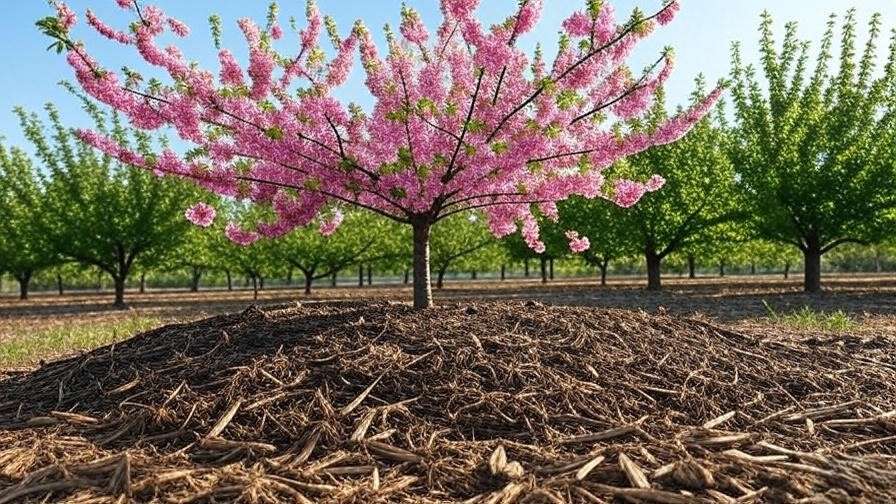
Proper Planting Techniques
Correct planting sets the stage for healthy roots:
- Dig a wide, shallow hole: Aim for a hole twice as wide as the root ball but no deeper than its height.
- Position the root crown: Keep it slightly above soil level to prevent moisture buildup.
- Backfill with loose soil: Avoid compacting the soil tightly around roots.
Pro Tip: Add a 2-inch layer of gravel at the hole’s base in clay-heavy soils to enhance drainage.
Watering and Irrigation Best Practices 💧
Watering correctly prevents root rot:
- Deep, infrequent watering: Water every 7–10 days, delivering 1–2 inches of water to encourage deep roots.
- Drip irrigation: Use drip lines or soaker hoses to target the root zone without wetting the trunk.
- Monitor moisture: A soil moisture meter ensures you’re not overwatering.
For young trees, check soil moisture weekly to establish a routine. Mature trees may need less frequent watering, depending on climate.
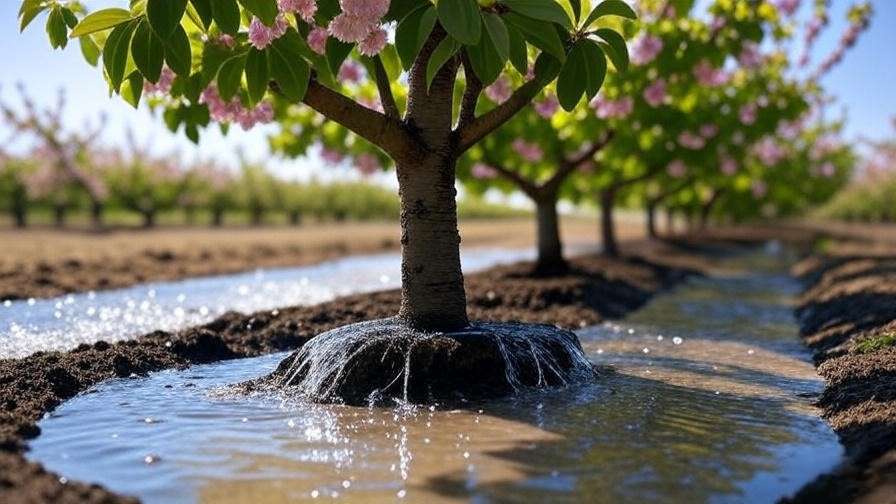
Mulching and Soil Management
Mulch protects roots but must be applied correctly:
- Apply 2–4 inches of mulch: Use organic materials like wood chips or bark, keeping it 6 inches from the trunk.
- Aerate soil annually: Use a garden fork to loosen compacted soil around the root zone.
- Rotate cover crops: Planting clover or alfalfa nearby improves soil structure and nutrient content.
Proper mulching retains moisture without creating a fungal haven.
Selecting Resistant Cherry Tree Varieties
Some cherry tree varieties resist root rot better:
- Montmorency: A tart cherry with strong resistance to Phytophthora.
- Stella: A sweet cherry with good disease tolerance.
- Rootstocks: Mazzard or Mahaleb rootstocks enhance resistance in grafted trees.
Research from the University of California shows that Mazzard-rooted trees survive wet conditions better than others. Consult your local nursery for resistant varieties suited to your region.
Treatment Options for Cherry Tree Root Rot 🩺
Early Intervention Strategies
If you catch root rot early, you can often save your cherry tree with prompt action. Here’s how:
- Prune affected roots: Carefully excavate the root zone and use sterilized pruners to remove dark, mushy roots. Cut back to healthy, white tissue. Disinfect tools with a 10% bleach solution after each cut to prevent spreading pathogens.
- Improve drainage: If the soil is waterlogged, dig shallow trenches around the tree to redirect water or create a raised bed. For severe cases, consider installing a French drain.
- Apply fungicides: Use phosphite-based fungicides labeled for root rot, such as those containing potassium phosphite. Follow label instructions carefully, as overuse can harm the tree. Apply as a soil drench or trunk injection for best results.
Early intervention can save up to 80% of mildly affected trees, according to research from Oregon State University. Act quickly to maximize recovery chances.
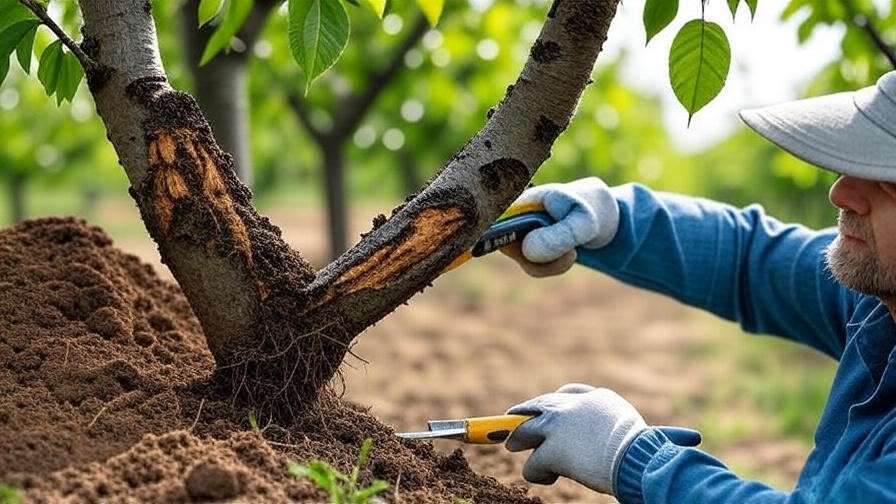
When to Remove and Replace a Tree
Sometimes, root rot is too advanced to treat. Signs a tree is beyond saving include:
- Extensive root decay: More than 50% of the root system is mushy or blackened.
- Severe canopy decline: Most leaves are wilted, and branches are brittle or dead.
- No response to treatment: No improvement after 4–6 weeks of intervention.
To remove a tree:
- Cut it down safely: Hire a professional for large trees to avoid injury or property damage.
- Remove the root system: Dig out as much of the infected roots as possible to prevent fungal spread.
- Treat the soil: Solarize the soil by covering it with clear plastic for 4–6 weeks during summer to kill lingering pathogens. Alternatively, apply a biofungicide like Trichoderma to suppress fungi.
Pro Tip: Before replanting, wait at least one growing season and test the soil to ensure it’s pathogen-free.
Working with Professionals
For severe cases or uncertainty, consult a professional:
- Certified arborists: They can assess the tree’s health and recommend treatments like systemic fungicides or soil amendments.
- Extension services: Local agricultural extensions, such as those affiliated with land-grant universities, offer affordable soil testing and pathogen identification.
- Cost considerations: Soil tests typically cost $20–$50, while arborist consultations range from $100–$300, depending on the region.
A Michigan orchard owner saved 15 of 20 infected cherry trees by working with an arborist who identified Phytophthora and implemented a drainage overhaul. Professional help is often worth the investment for valuable trees.
Long-Term Care for Healthy Cherry Trees 🌿
Regular Monitoring and Maintenance
Preventing future root rot requires ongoing vigilance:
- Annual root inspections: Check a small section of the root zone each spring for signs of decay.
- Soil testing: Test soil pH and nutrient levels every 1–2 years to ensure optimal conditions (pH 6.0–7.0, balanced nitrogen, phosphorus, and potassium).
- Pruning: Remove dead or crowded branches in late winter to improve air circulation and reduce fungal risk. Use clean, sharp tools to avoid stress or infection.
- Fertilization: Apply a balanced fertilizer (e.g., 10-10-10) in early spring to boost tree resilience. Avoid over-fertilizing, as excess nitrogen can weaken roots.
Regular care strengthens trees against diseases and environmental stress.
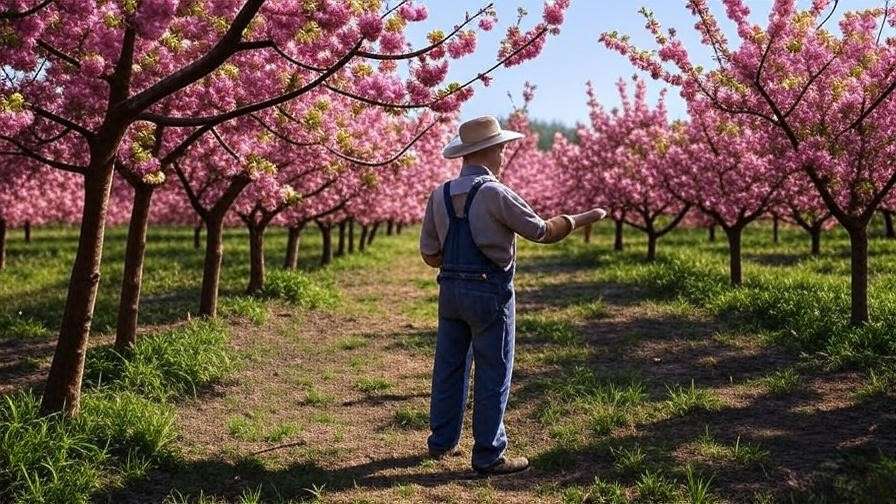
Integrated Pest and Disease Management
A holistic approach minimizes root rot risk:
- Cultural controls: Maintain proper watering, mulching, and planting practices as outlined above.
- Biological controls: Introduce beneficial microbes like mycorrhizal fungi to enhance root health. Products containing Trichoderma harzianum can suppress pathogenic fungi.
- Chemical controls: Use fungicides sparingly as a last resort, focusing on prevention through environmental management.
Dr. Robert Miller, a plant pathologist at Washington State University, emphasizes, “Integrated management combines proactive care with targeted interventions, reducing reliance on chemicals and promoting long-term tree health.” This approach ensures your orchard remains resilient.
FAQs About Cherry Tree Root Rot ❓
What are the first signs of root rot in cherry trees?
Early signs include yellowing or wilting leaves, sparse fruit production, and stunted growth. Below ground, check for dark, mushy roots with a foul odor.
Can a cherry tree recover from root rot?
Yes, if caught early and less than 50% of the root system is affected. Prune damaged roots, improve drainage, and apply fungicides as needed.
How often should I water my cherry tree to prevent root rot?
Water deeply every 7–10 days, ensuring 1–2 inches of water reaches the root zone. Use a moisture meter to avoid overwatering.
Are there natural remedies for root rot?
Beneficial microbes like Trichoderma and soil amendments like compost can help. However, severe cases may require fungicides or professional intervention.
How can I tell if my soil has poor drainage?
Dig a 12-inch hole, fill it with water, and time how long it takes to drain. If it takes over 4 hours, drainage is poor and needs amendment.
These answers draw on research from trusted sources like the USDA and university extensions, ensuring accuracy and reliability.
Additional Resources for Cherry Tree Care 📚
- Books: “The Home Orchard” by UC Agriculture and Natural Resources provides practical tree care tips.
- University Extensions: Visit Cornell University (extension.cornell.edu) or UC Davis (ucanr.edu) for region-specific advice.
- Online Tools: SoilWeb (casoilresource.lawr.ucdavis.edu) offers free soil data to assess drainage and composition.
These resources empower you to deepen your knowledge and maintain a healthy orchard.
Conclusion 🌈
Cherry tree root rot is a serious threat, but with the right knowledge, you can protect your orchard from its devastating effects. By learning to identify early warning signs—yellowing leaves, mushy roots, and poor fruit yield—you can act swiftly to save your trees. Prevention is key: choose well-draining sites, plant resistant varieties like ‘Montmorency,’ and maintain proper watering and mulching practices. If root rot strikes, early intervention with pruning, drainage improvements, or fungicides can make all the difference. For long-term success, adopt integrated management and regular monitoring to keep your cherry trees thriving.
Take the first step today: inspect your trees, test your soil, or consult an arborist to ensure your orchard bursts with juicy cherries for years to come. Share your experiences in the comments or reach out to a local extension service for personalized advice. Your thriving cherry orchard awaits! 🌸

